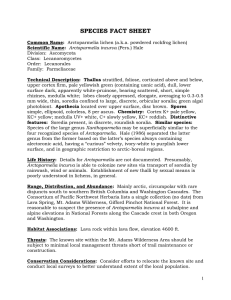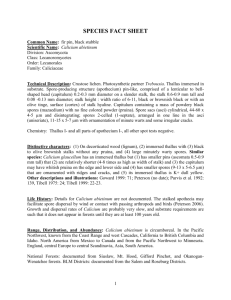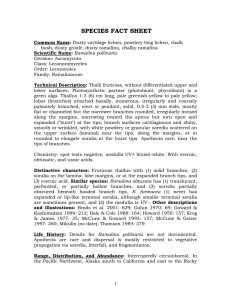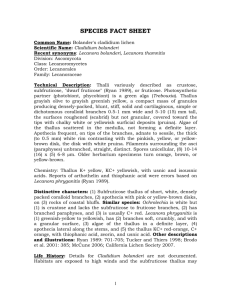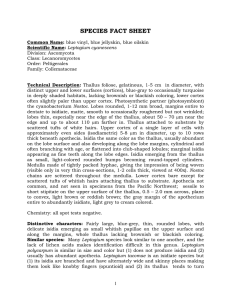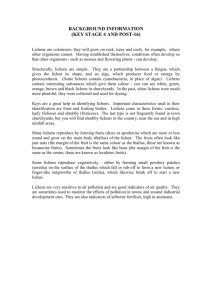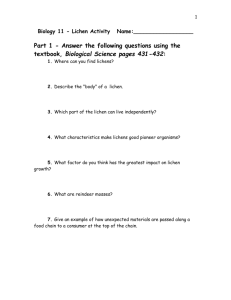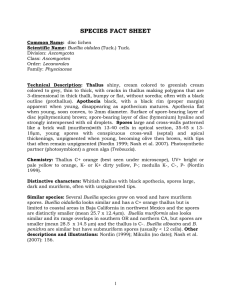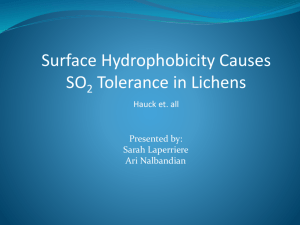SPECIES FACT SHEET - USDA Forest Service
advertisement
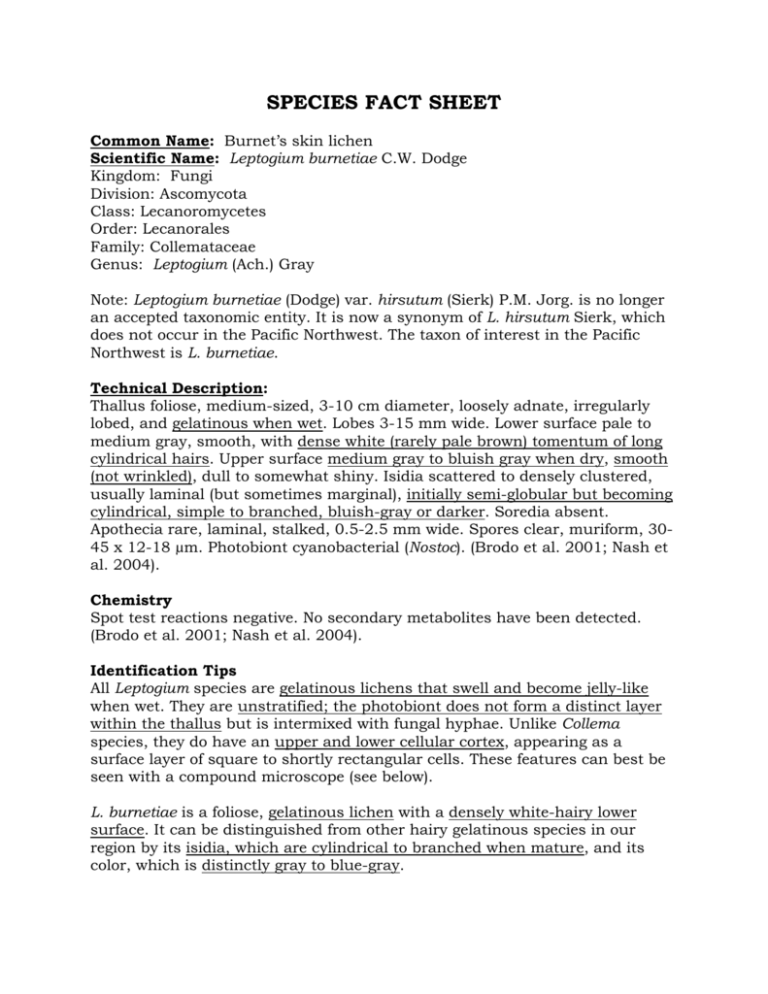
SPECIES FACT SHEET Common Name: Burnet’s skin lichen Scientific Name: Leptogium burnetiae C.W. Dodge Kingdom: Fungi Division: Ascomycota Class: Lecanoromycetes Order: Lecanorales Family: Collemataceae Genus: Leptogium (Ach.) Gray Note: Leptogium burnetiae (Dodge) var. hirsutum (Sierk) P.M. Jorg. is no longer an accepted taxonomic entity. It is now a synonym of L. hirsutum Sierk, which does not occur in the Pacific Northwest. The taxon of interest in the Pacific Northwest is L. burnetiae. Technical Description: Thallus foliose, medium-sized, 3-10 cm diameter, loosely adnate, irregularly lobed, and gelatinous when wet. Lobes 3-15 mm wide. Lower surface pale to medium gray, smooth, with dense white (rarely pale brown) tomentum of long cylindrical hairs. Upper surface medium gray to bluish gray when dry, smooth (not wrinkled), dull to somewhat shiny. Isidia scattered to densely clustered, usually laminal (but sometimes marginal), initially semi-globular but becoming cylindrical, simple to branched, bluish-gray or darker. Soredia absent. Apothecia rare, laminal, stalked, 0.5-2.5 mm wide. Spores clear, muriform, 3045 x 12-18 µm. Photobiont cyanobacterial (Nostoc). (Brodo et al. 2001; Nash et al. 2004). Chemistry Spot test reactions negative. No secondary metabolites have been detected. (Brodo et al. 2001; Nash et al. 2004). Identification Tips All Leptogium species are gelatinous lichens that swell and become jelly-like when wet. They are unstratified; the photobiont does not form a distinct layer within the thallus but is intermixed with fungal hyphae. Unlike Collema species, they do have an upper and lower cellular cortex, appearing as a surface layer of square to shortly rectangular cells. These features can best be seen with a compound microscope (see below). L. burnetiae is a foliose, gelatinous lichen with a densely white-hairy lower surface. It can be distinguished from other hairy gelatinous species in our region by its isidia, which are cylindrical to branched when mature, and its color, which is distinctly gray to blue-gray. Similar Species Collema species are also darkly-colored gelatinous lichens, but they lack an upper and lower cellular cortex. This can be observed with a wet mount of the thallus and a compound microscope; see illustrations on page 15 in Brodo et al. (2001). In addition, Collema species are never hairy. Leptochidium albociliatum may have a white-hairy lower surface, but can be distinguished by marginal whitish hairs on the upper surface; they are usually abundant and conspicuous with a hand lens. Leptogium saturninum is most similar to L. burnetiae. L. saturninum can be distinguished by its olive to blackish color (rather than bluish-gray), and usually granular or globular isidia (Brodo et al. 2001; Jørgensen 1997). It also has thicker lobes and becomes more gelatinous when wet (Nash et al. 2004). These two can be difficult to separate. Leptogium pseudofurfuraceum has a white-tomentose lower surface and cylindrical isidia. However, unlike L. burnetiae, it has a finely wrinkled upper surface, and a reddish-brown to brown-gray color. Keys to Identification of the Species Useful dichotomous keys are available in Brodo et al. (2001), Goward et al. (1994), and Nash et al. (2004). L. burnetiae keys to L. hirsutum in McCune & Geiser (1997). Life History: L. burnetiae is often sterile, producing apothecia only occasionally. However, it reproduces asexually through abundant isidia, which are usually present yearround. The thallus is visible and identifiable year-round, unless visibility is impeded by snow cover or inclement weather. Range, Distribution, and Abundance: Globally, this species is widespread in the montane tropics, extending into warm temperate regions of Asia, Africa, Europe and North America (Nash et al. 2004). In the Pacific Northwest, it occurs from northern Oregon to Alaska. There is some uncertainty about the number of known sites in the Northwest Forest Plan Area. It has been verified from only three locations in Oregon and Washington: one at Saddle Mountain State Park, Oregon and two in the Columbia River Gorge National Scenic Area (ver. by Trevor Goward, pers. comm. Andrea Ruchty). These occur in the Oregon Coast Range and Eastern Washington Cascades Physiographic Provinces. There are two additional records from Washington; these specimens are awaiting verification. Fact Sheet for Leptogium burnetiae 2 Habitat Associations: This species is found on tree bark, and also on mossy rocks. In the Columbia River Gorge it occurs on Quercus garryana bark in a ponderosa pine/ garry oak/ arrowleaf balsamroot plant association at low elevations (100 and 400 feet). In Alaska, it is known from the Tongass National Forest at low-elevation sites (≤ 250 feet), where it occurs on Alnus sinuata, Picea sitchensis, Salix sp., and Populus trichocarpa (U.S. Department of Agriculture 2006). In the Sonoran desert region, it occurs on rocks and a cliff faces at high elevations (2600 m and 1900 m)(Arizona State University 2006). Threats: The primary threat to this species is forest management activities that remove host trees or degrade habitat. Timber harvest projects that remove or damage oaks, cottonwoods, and other hardwoods may directly threaten populations or reduce habitat. Conservation considerations: Known populations could be protected by restricting removal of host trees and nearby habitat. Preparers: Erika Wittmann & Jeanne Ponzetti Date completed: 9/18/2006 ATTACHMENTS: (1) (2) List of References Map The map included here is a product of a query of the Agencies’ databases as of October 2006, and does not include all of the sites mentioned in this Fact Sheet. Some sites have not been input into the databases, and are therefore missing from the map. In addition, sites needing verification may be within the Agency database, and hence included on this map. Fact Sheet for Leptogium burnetiae 3 Attachment 1 – List of References Arizona State University. 2006. Lichen Herbarium. Database available online at: http://seinet.asu.edu/collections/selection.jsp. Brodo, I., Sylvia Sharnoff, & Stephen Sharnoff. 2001. Lichens of North America. New Haven, CT: Yale University Press. 795 pp. Esslinger, T. L. 2006. A cumulative checklist for the lichen-forming, lichenicolous and allied fungi of the continental United States and Canada. North Dakota State University: http://www.ndsu.nodak.edu/instruct/esslinge/chcklst/chcklst7.htm (First Posted 1 December 1997, Most Recent Update 10 April 2006), Fargo, North Dakota. Goward, T., B. McCune, & D. Meidinger. 1994. The Lichens of British Columbia: Illustrated Keys. Part 1 – Foliose and Squamulose Species. Special Report Series 8, British Columbia Ministry of Forests Research Program. Victoria, B.C.: Crown Publications. 181 pp. Jørgensen, P.M. 1997. Further notes on hairy Leptogium species. Symb. Bot. Ups. 32: 1. McCune, Bruce, & Linda Geiser. 1997. Macrolichens of the Pacific Northwest. Corvallis, OR: Oregon State University Press. 386 p. Nash, T.H.III, B.D. Ryan, P. Diederich, C. Gries, F. Bungartz, editors. 2004. Lichen flora of the greater Sonoran Desert region: volume II. Tempe, AZ: Lichens Unlimited & Arizona State University. 742 p. USDA, NRCS. 2006. The PLANTS Database (http://plants.usda.gov, 6 August 2006). National Plant Data Center, Baton Rouge, LA 70874-4490 USA. U.S. Department of Agriculture. 2006. Pacific Northwest Region Lichens and Air Quality. Lichen Community Data. U.S. Forest Service Region 6. Available online at: http://www.lichenair.nacse.org/cgibin/qml/usair/region6/area6.qml. Fact Sheet for Leptogium burnetiae 4 Attachment 2 – Map of Leptogium burnetiae locations in Oregon and Washington from GeoBOB database The map included here is a product of a query of the Agencies’ databases as of October 2006, and does not include all of the sites mentioned in this Fact Sheet. Some sites have not been input into the databases, and are therefore missing from the map. In addition, sites needing verification may be within the Agencies’ databases, and hence included on this map. (The name of the species on this map has not been changed to the correct name, Leptogium burnetiae). Fact Sheet for Leptogium burnetiae 5
